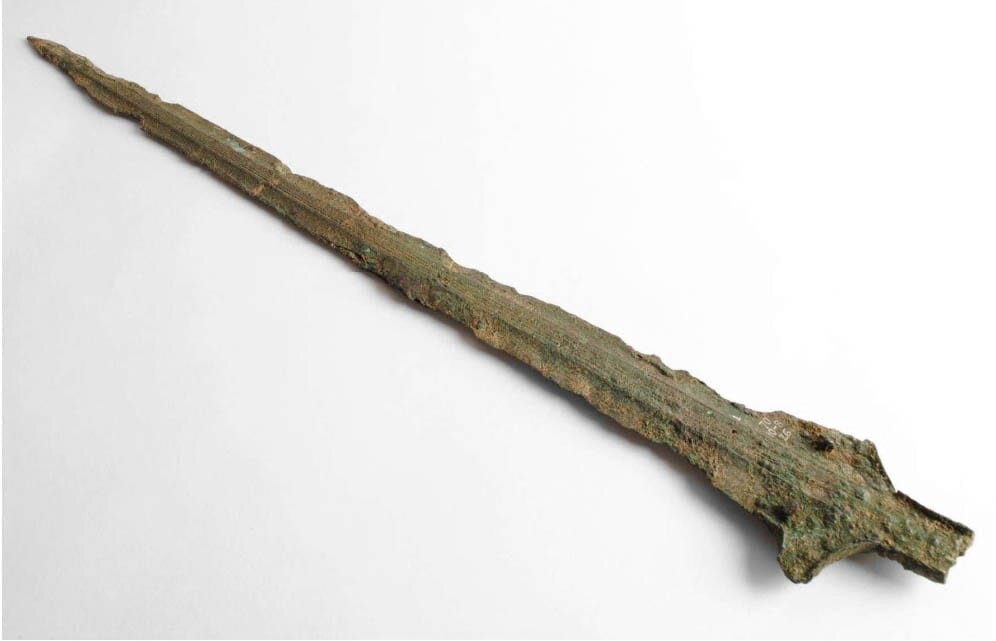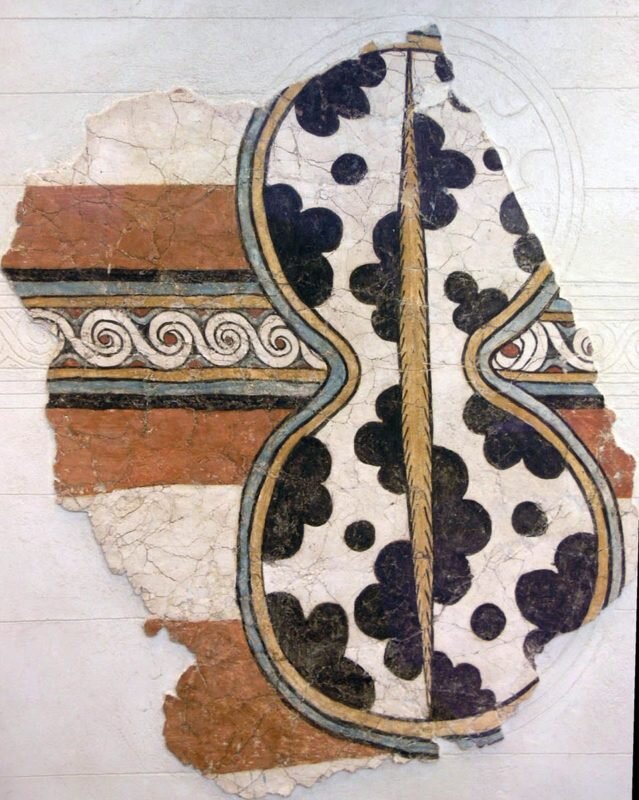Greek armor and weapons from Mycenaean civilization survive today in archaeological remains from tombs, artistic depictions, and linguistic evidence.
By Elliott McDonald, The collector
Fresco of a Figure Eight shield from Mycenae Acropolis, 15th century B.C.; Tower and Figure Eight shields on the famous Lion Hunt dagger from Mycenae, 16th century B.C.; Mycenaean warriors preparing for battle, via weaponsandwarfare.com
The Acheans were a group of Indo-Europeans who arrived in Greece in the Early Bronze Age. Warrior-based kingdoms would eventually rise throughout the Greek mainland and islands in cities such as Thebes, Pylos, and Mycenae. Nearby powers such as Knossos in Crete were also subsumed under the Achaean influence. The citadel of Mycenae was excavated by archaeologist Heinrich Schliemann in the nineteenth century. The treasures found within demonstrated a grandeur unmatched elsewhere in Europe – and showed Achean Greece or the ‘Mycenaean civilization’ was a Bronze Age power alongside Egypt, Assyria, Phoenicia and the Hittites. The rise of this militaristic society, and the development of Greek armor and weapons, would eventually grant the Mycenaeans immortality through the literary preservation of one of their great conflicts: the Trojan War.
Greek Weapons From Mycenaean Civilization
1. Swords
A straight-edged Greek sword from Ialysus, 1400-1060 B.C., Rhodes, via the British Museum, London
Today, swords are viewed as ubiquitous military armaments. However, in Early Bronze Age Europe, these objects did not exist. Large-scale close-quarters conflict rarely occurred, and there is evidence that elsewhere in Europe ritualized duels involving halberds may have formed part of dispute-resolution. Other tools such as spears and axes could be pressed into service in a combat situation and had other uses. Swords used large amounts of valuable bronze and were useless for hunting due to a lack of reach. Their introduction as an object designed specifically for use against other humans marks the growth of conflict as a part of society.
Three main sword forms are known from Mycenaean period Greece. Early variants had rounded tips and thin, long blades measuring around 130cm. These straight-edged swords initially arrived via Crete and were riveted to a wooden or ivory handle. Examples from Staphylos and Mycenae show handles were occasionally inlaid with gold leaf. Subsequent refinement of the weapon on the Greek peninsula led to the development of integral bronze handles. Grave Circle A in Mycenae contained several examples of gilded sword belts, used to suspend these weapons from the warrior’s waist.
Reconstructed Mycenaean sword types: Early, Naue II, and Single-edged, via The Journal of Society of Ancients
The second blade type to arrive in Greece was a single-edged weapon, more suited for close-quarters fighting. These pieces were again forged from a single piece of bronze for stability. Single-edged swords have a hooked handle suggesting they were hung directly from a belt.
Greek weapons were revolutionized by the 1200 B.C. with the arrival of the slashing sword. This design originated in Italy but then spread north into Britain and Scandinavia, only reaching Mycenaean civilization centuries later. Known as the Naue II type, these swords were markedly different from their predecessors. The blades tapered gently to a point, which improved thrusting ability. More significantly, the blades were shorter and some had a heavier ‘leaf’ shape, allowing the weapons to be used in a wide-arcing slashing style to cut through both armor and flesh. In the Mycenaean armies, sword bearers were lightly armored infantry. Their maneuverability made them suitable for undulating terrain and for carrying out high-risk tactical movements. Such acumen earned sword-bearers the title of promachoi, or champions.
2. Spears
Mycenaean spearhead from Ialysus, 1400-1060 B.C., Rhodes, via the British Museum, London
Spears are perhaps the most common weapon type in human history and have been used in hunting since the Palaeolithic era. This role continued in Mycenaean civilization. Boars were hunted for their tusks, used in helmets, while lions were hunted as a noble pursuit and to teach agility and discipline. The famous Lion Hunt Dagger from Shaft Grave IV in Mycenae depicts such an event. In pursuing these dangerous animals, the spear was invaluable due to its flexibility and long reach. In the Bronze Age, the spear had another advantage – they used much less bronze than large bladed weapons such as swords and doubled-edged axes. This meant even lower class citizens could afford a spear, and it was easier to equip large bodies of men in times of war.
Spearmen on the Mycenaean warrior vase, in the National Archaeological Museum of Athens, via Scala Archives
Achean spears have been recovered from across excavations across Bronze Age Greece and Knossos. Most were cast using the ‘lost wax’ method to create a socketed base for ease of attachment. The spearheads vary in size and form, from large leaf-shaped examples to much smaller blades with wings above the socket. These disparities likely reflect differences in combat styles, sometimes visible in artistic depictions. Longer spears would be wielded two-handed and used in a thrusting motion, visible in frescoes from Pylos. The longer reach would also be invaluable if fighting from the Mycenaean civilization’s war chariot. Shorter examples were used one-handed with a shield and could be thrown if necessary. A fresco from Akrotiri on Thera depicts spear and shield warriors in a close formation. This suggests the main component of Aegean armies were clustered bodies of armored spearmen, not dissimilar to the later Classical Greek phalanx.
3. Axes
Labrys Double Head Axe, in the Heraklion Archaeological Museum, via The Incredibly Long Journey (above); with Copper Shaft-hole Axe, 15th-13th century B.C., via the British Museum, London (below)
Axes were a fascinating category of Greek weapons. Simple bronze flat or flanged axes were used throughout Greece from the early Bronze Age onwards as utility tools and makeshift weapons. However, in the 15th century, the Mycaneans occupied Minoan Crete, which had collapsed due to the gigantic Thera eruption or a similarly sized earthquake. In Minoan society, the double-axe or labrys was a cult symbol with possible proto-Elamite and Egyptian influences. The objects were associated with a female Minoan chthonic deity possibly known as Ashera. Elaborate double-axes were mounted on large pyramidal mounts known as ax-stands, forming part of ceremonial and religious centers known from Nirou Khani and Knossos.
The double-ax was adopted by the Mycenaean civilization in Crete for religious purposes. However, the form of the double-ax also made its way to mainland Greece. Simple undecorated forms have been found in Pylos, Mycenae, and the famous Tomb of Clytemnestra. These sturdy objects were likely pressed into service as weapons. They provided the flexibility of two cutting edges, and the added weight, whilst cumbersome enhanced any armor-piercing ability. An unusual purpose-built battle-ax is known from Vapheio. The object is semi-circular with two large holes – making it a light and deadly one-handed weapon.
4. Bow And Arrow
V-shaped (top) and Tanged (bottom) bronze arrowheads, 1400-1060 B.C., via the British Museum, London
Bows had been used for hunting since the Paleolithic era, but archaeological evidence from Mycenaean Greece is scarce. In the powerful contemporary Bronze Age kingdoms of Egypt and Hatusha, the bow was a weapon of great importance. The desert expanses of the Near East favored open battles featuring large numbers of bow-armed charioteers. This was most famously seen at the Battle of Kadesh between the Egyptians and the Hittites in 1274. The rocky terrain of Greece was less suited to the bow, so it was likely less frequently used. Furthermore, the Greek climate rarely preserves organic material such as wood, unlike the arid conditions of Egypt. Bows are, however, frequently depicted on finger rings, drinking vessels and seals from shaft graves. These objects were designed to be used conspicuously, and show that bows were still important objects and symbols of martial prowess.
Two main bow types appear in depictions of Greek weapons. The first is the simple curved or ‘self’ bows in a simple crescent shape. These weapons could be made easily by a craftsman as long as suitable wood was available. The second main type is the recurve bow, with limbs curving away from its holder, this bow will loose arrows stronger and faster than a self bow. However, recurve bows are typically more complex to make, utilizing horns on the inner side of the bow to produce greater tension and energy. The Homeric sources suggest Odysseus’ bow was a composite recurve, as the pests associated with his weapon were typical of horn, not wood.
Arrows were as important as the bows themselves. Despite the emergence of bronze arrowheads, flint and obsidian examples continued to be used in the Mycenaean period for several reasons. Flint and obsidian were harder than bronze, produced sharper cutting edges, and could be resharpened. Heart-shaped variants with reduced weight became popular. Bronze arrowheads were utilized due to their flexibility, with an archer likely carrying several types. Narrow, v-shaped examples from Knossos would be effective at piercing bronze armor, while tanged arrows would be difficult to remove.
5. Greek Armor From Mycenaean Civilization
Tower and Figure Eight shields on the famous Lion Hunt dagger from Mycenae, 16th century B.C., via Ancient World Magazine
Shields have become one of the iconic images of Mycenaean Greek armor due to their size and vivid depictions of frescos and pottery. Shields made of solid bronze did not appear until the later Bronze age. Mycenaean shields were produced in a long process involving adding from layers of hardened bull-hide onto a wooden frame. Bronze was sometimes used to make plates and bosses for reinforcement, and for shield rims. The composite nature of these objects meant they could be easily repaired, however, as organics, complete examples do not survive. Our knowledge about shields is based on remaining metallic components and depictions. Shields came in a variety of sizes depending on the role of the warrior. Skirmisher troops and light infantry utilized small shields of varying shapes. Heavier troops used three main types.
Early Mycenaean soldiers used rectangular tower shields. These are visible on numerous frescoes from 1600 B.C. onwards, and personal equipment such as the famous ‘Lion Hunt Dagger’ from Mycenae. Bronze rims and staples survive in graves from Mycenae, Knossos and Haghios Joannis. These shields were very large, covering most of the body. They were therefore attached to the bearer’s shoulder alongside the usual grip or baldric to improve maneuverability.
Fresco of a Figure Eight shield from Mycenae Acropolis, 15th century B.C., in the National Archaeological Museum of Athens, via Ancient History Encyclopedia.
So-called ‘Figure Eight’ shields are known from the 15th century onwards. This unique design is synonymous with Mycenaean Greek armor and consists of two pieces of curved wood with various supporting elements. The gaps were then filled with wicker before the layers of ox-hide were added. The three-dimensional curves of this shield provided a large internal space, and seal depictions show it could almost ‘enclose’ the bearer. It provided greater protection than a rectangular or flat shield and most Greek armor. Archaeological remains of this type may be limited to a group of copper fittings for leather from Knossos. However, the design is well-known from martial scenes, and individual depictions, on frescoes, seals, and pottery vessels. Figure Eight shield imagery is known from the palaces at Tiryns and Pylos, and small votive examples are also known, suggesting the objects had prestigious ritual associations.
The later Mcyeanaen period saw advances in Greek armor, including the development of widespread bronze pieces. These allowed soldiers greater protection without the encumbrance of tower and figure of eight shields. A lighter shield known as the proto-dipylon shield grew in popularity. The device was oval-shaped with cut-outs on opposing sides to accommodate the bearer’s spear. Proto-dipylon shields lacked the cultural significance of Figure Eight shields, and are mainly represented in pendant form. However, they were the only variant to continue in use in the following Geometric period, where their design helped pave the way for the rise of the Classical Greek phalanx.
Read more at: www.thecollector.com

















